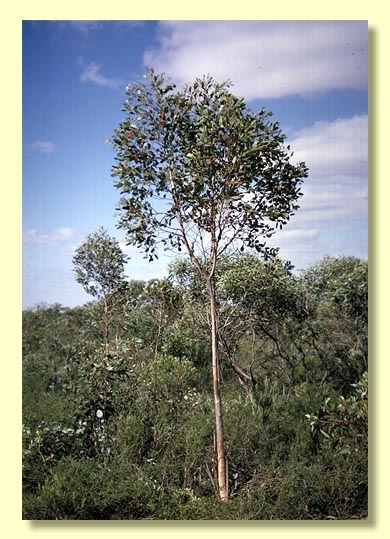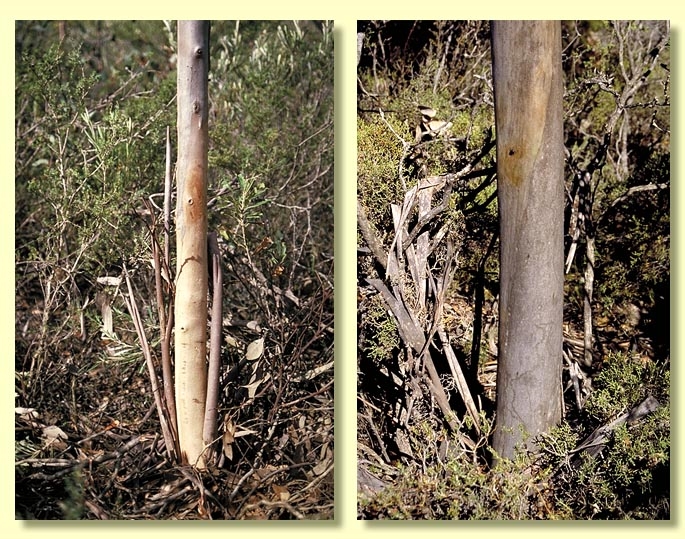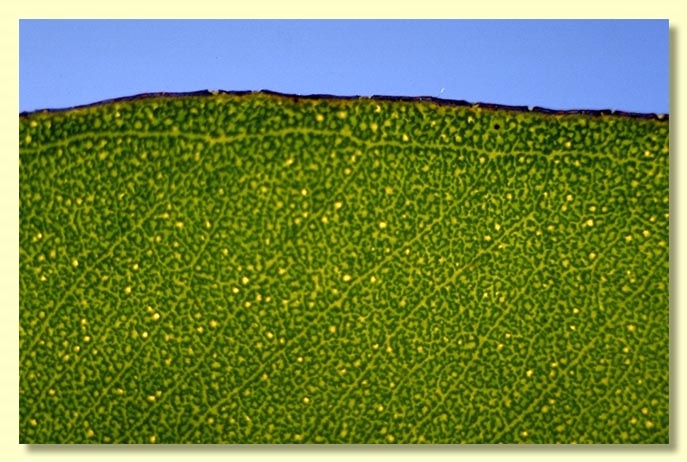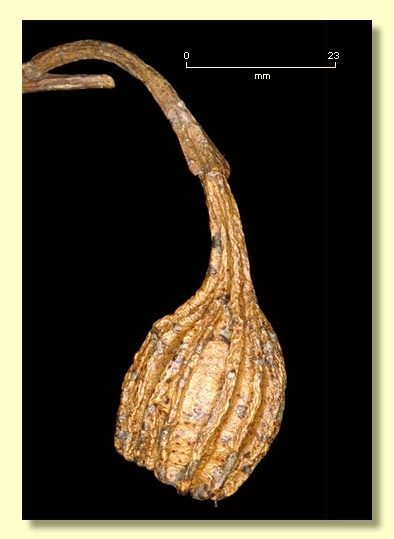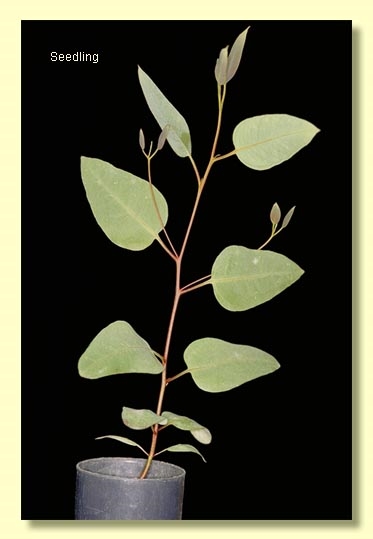Euclid - Online edition
Eucalyptus stoatei
Eucalyptus | Symphyomyrtus | Dumaria | Tetrapterae
Bark wholly smooth grey over brown to cream, shedding in strips.
Branchlets lacking oil glands in the pith.
Juvenile growth (coppice or field seedlings to 50 cm): stems square in cross-section; juvenile leaves always petiolate, alternate, usually ovate to oblong, 5–8.5 cm long, 4–6.5 cm wide, base tapering to rounded, apex rounded to pointed, bluish green becoming green and glossy at upper nodes.
Adult leaves thick, alternate, petioles 1–2.2 cm long; blade elliptical to oblong, 5–8 cm long, (1.4)1.7–3.5 cm wide, base tapering to petiole, margin entire, apex pointed to rounded, concolorous, glossy, mid-green, side-veins greater than 45° to midrib, reticulation dense to very dense or obscure, intramarginal vein remote from margin, oil glands intersectional or obscure.
Inflorescence axillary unbranched, pendulous, peduncles rounded proximally, broadening and flattening distally, 2–7 cm long; bud solitary, pedicellate, pedicels 0.7–1 cm long. Mature buds obovoid with many longitudinal ribs, red, (2.9–5.5 cm long, 1.3–2.5 cm wide), scar present, outer operculum ceases to grow but remains on apex of inner operculum, inner operculum broadly conical (0.6–2 cm long), stamens inflexed, filaments glandular, anthers cuboid, versatile, sub-basifixed, dehiscing by longitudinal slits, style long and straight, stigma tapered, locules 3, the placentae each with (8)10 vertical rows of ovules. Flowers yellow.
Fruit pendulous, pedicellate, pedicels 0.4–2.5 cm long, barrel-shaped with many longitudinal ribs, 2.2–4 cm long, 1.8–3 cm wide, disc descending vertically, valves 3, enclosed.
Seeds brown, 3–5 mm long, pyramidal to obliquely pyramidal, prominently ridged, the ridges continuous with the marginal flange, dorsal surface shallowly reticulate, hilum terminal.
Cultivated seedlings (measured at ca node 10): cotyledons reniform; stems square to rounded in cross-section; leaves always petiolate, opposite for ca 4 nodes then alternate, ovate, 5.5–8 cm long, 3–5.5 cm wide, dull, grey-green becoming slightly glossy by 8–10 nodes.
Flowering has been recorded in January, February, September and November.
E. stoatei is becoming a popular ornamental, often not as tall as E. dolichorhyncha or E. forrestiana.
A mallet endemic to Western Australia, of restricted subcoastal distribution west and north-west of Esperance to the Cascades area, as an emergent in heath on sandplains. The bark is smooth and the adult leaves glossy green and flower buds solitary in the leaf axils..
Eucalyptus stoatei belongs in Eucalyptus subgenus Symphyomyrtus section Dumaria because the buds have two opercula, stamens are strongly inflexed, ovules occur in (8)10 rows on the placentae and cotyledons are reniform. E. stoatei forms a small subgroup (series Tetrapterae) with E. tetraptera, E. forrestiana and E. dolichorhyncha, all with single-flowered inflorescences with buds that are ultimately red, all lacking oil glands in the pith of the branchlets, and with blackish pyramidal seed.
The many-ribbed large pear-shaped buds distinguish E. stoatei from its near relatives, all of which have four-winged buds square in cross-section. E. stoatei, E. forrestiana and E. dolichorhyncha have yellow stamens whilst E. tetraptera (and two newly described close relatives E. brandiama and E. sweedmaniana ) have pink-red stamens.

